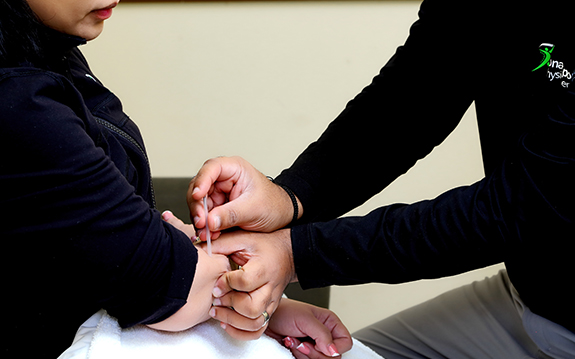Dry Needling Therapy, also known as Trigger Point Dry Needling or Myofascial Trigger Point Dry Needling, involves inserting thin needles into the body’s trigger points or tight muscles. This technique treats myofascial pain (with “myo” meaning muscle and “fascia” referring to the connective tissue). The primary goal is to enhance tissue healing and restore muscle function. The needles may be placed deeply or superficially, for shorter or longer periods depending upon the type of pain being treated.
Occasionally, muscles can form sensitive, painful knots known as trigger points. A physiotherapist inserts thin, solid needles through the skin into these trigger points to stimulate the tissue, without injecting any medication.
Patients may experience various sensations, such as muscle soreness, aching, or a muscle twitch during the procedure, which are considered positive signs of effective treatment.

Principles Of Dry Needling Therapy
The principles of dry needling (DN) application include patient education and consent, procedural education, and practical application, such as proper positioning and palpation.
Procedural-education
DN requires during the procedure:
- The patient is asked and encouraged to provide feedback and communicate with the clinician during treatment.
- The patient is asked to remain still during the procedure.
- In the case of trigger points (TrPts)-DN, the patient should be made aware of the local twitch response (LTR) which may be perceived as similar to an electric shock or other sensation. The patient should be made aware that the reproduction of the LTR is the aim of TrPts-DN.
Positioning
Positions may include supine, prone, side-lying, or a combination of these positions. The patient must be comfortable and relaxed. Pillows or rolls etc can be used for positioning.
Conditions Treated
Dry Needling is usually used as a part of an overall plan. It is used to increase the range of motion that may be restricted due to muscle tightness or scar tissue. It may also help to treat:
- Low back pain
- Neck pain
- Elbow pain
- Spinal Dysfunction
- Migraines
- Joint Dysfunction
- Sciatica
- Disc Problems
- Tendinitis
- Jaw and Mouth Problems (such as Temporomandibular Joint Disorders or TMJ)
- Repetitive Motion Disorders (Like carpal tunnel syndrome)
- Pelvic Pains
- Night Cramps
- Post-Herpetic Neuralgia
Visit Scona Sports & Physiotherapy for Dry Needling in Edmonton
Dry needling is a highly effective technique that can be used to treat a wide range of musculoskeletal conditions and improve overall muscle function. It is often used in conjunction with other physiotherapy treatments, such as exercise therapy, manual therapy, and education on proper body mechanics.
At Scona Sports & Physiotherapy in Edmonton, our team of experienced physiotherapists is well-versed in the practice of dry needling and its many benefits. We work closely with each patient to create an individualized treatment plan that addresses their specific needs and goals.
If you are experiencing persistent muscle pain or limited range of motion, dry needling at our facility in Edmonton may be a beneficial treatment option for you. Our goal is to provide exceptional care and support to all our patients, helping them achieve long-term relief from pain and injury.
Why Us?
At Scona Sports & Physiotherapy, we are dedicated to providing the highest quality of care and achieving optimal results for our patients. Our team consists of highly trained and experienced physiotherapists who deeply understand human anatomy and physiology.
We believe in taking a holistic approach to treatment, addressing the symptoms, and identifying and treating the root cause of pain or dysfunction. With our comprehensive range of services, including chiropractic treatment, massage therapy, and dry needling in Edmonton, we can help you improve your physical health and well-being.
Contact Us
If you are interested in trying dry needling as part of your treatment plan or would like to learn more about our services, please don’t hesitate to contact us. Our friendly and knowledgeable staff will be happy to answer any questions you may have and schedule a consultation with one of our physiotherapists.
Visit Scona Sports & Physiotherapy today and let us help you on your journey towards improved mobility, strength, and overall wellness. Trust in our expertise and experience for effective treatment that gets results. Your body deserves the best care possible, and we are here to provide it.
